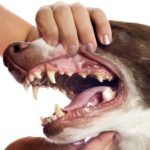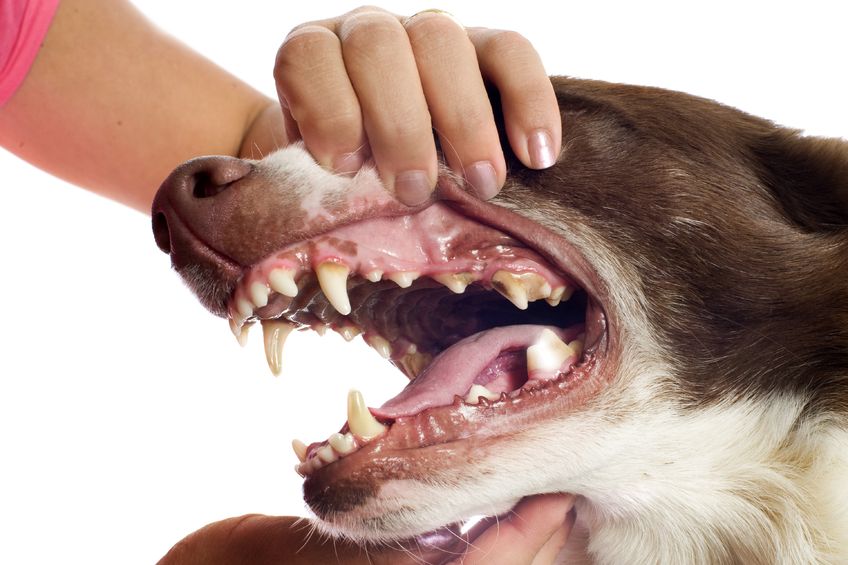Mouth and tooth disorder in dogs is quite common when it comes to their overall health. We should look after our dogs’ teeth and gums just as we do our own, to minimize the chances of disease. Regular dental checks, which can be carried out at a veterinary practice, are important to a dog’s health.
Signs of a Mouth, Tooth Problem
- Bad breath (halitosis)
- Discoloration of teeth
- Yellow deposit of calcified plaque on teeth
- Swelling on side of face (tooth root abscess)
- Gray discharge at gumline (pus from tooth root abscess)
- Difficulty eating, perhaps yelping with pain (rotten or broken tooth, something stuck across roof of mouth or between the teeth)
- Drooling saliva, pus, or blood
- Gum proliferation or growth
Plaque and Hygiene
In a healthy mouth, a dog’s teeth are white and his gums a pale pink. Ideally, the teeth should be brushed regularly at home to remove plaque, a soft colorless substance that accumulates on the teeth after eating.
With time, plaque hardens as yellow tartar or calculus, which needs to be removed with an ultrasonic scaler under general anesthetic.
Without intervention, plaque buildup can lead to gum disease, and teeth may ultimately loosen and fall out. If infection sets in, you may see pus at the gumline, or a swelling on the cheek caused by a tooth root abscess.
Your dog may have smelly breath or drool blood-tinged saliva; he may have trouble eating, perhaps pawing at his mouth because of pain and refusing hard treats and dried foods.

If your dog’s mouth is very painful, he may have to be anesthetized for the vet to find out exactly what is going on.
Teeth that cannot be saved will be extracted. Advanced dental procedures such as root canal treatment may be possible. After extractions, your dog will be discharged with antibiotics and pain relief.
Because plaque starts accumulating as soon as your dog starts eating again, vigilant home care is vital, together with regular dental checkups.
Retained Puppy Teeth
Sometimes the puppy teeth do not fall out when the adult versions break through. Having both sets can crowd the other teeth and create food traps, leading to infection. Your vet will probably recommend removal of any unwanted puppy teeth (most conveniently, this could be done when your puppy is anesthetized to be neutered).
Malocclusions
If a dog’s jaws are not aligned correctly, the teeth do not rest against each other normally, which is described as a malocclusion or, more commonly, an overbite or underbite. This can be a recognized feature of some breeds, but is regarded as a fault in others.
Malocclusion carries an increased risk of periodontal disease (that is, in the tissues surrounding the teeth) so careful dental hygiene, including tooth brushing, is very important.
Your vet will look for misaligned teeth at your puppy’s first check. Malocclusion can occasionally occur after an accident such as a fall onto the face.
Foreign Objects
Pieces of wood, chews, and bones can all become wedged across the roof of the mouth or between teeth. Sedation or general anesthesia may be needed to examine the mouth, remove the foreign object, and treat any injuries caused.
Jaw Drop
This curious condition is characterized by a sudden inability to close the mouth, together with excessive salivation and difficulty swallowing. Despite appearances, it is not painful. Fortunately, jaw drop usually cures itself over several days; the main concern is to ensure that your dog gets enough food and water.
Jaw Pain
Inflammation can sometimes develop in the muscles used for chewing, making it painful for a dog to eat. The dog may not be able to close his mouth fully and will drool saliva, looking as though he might have jaw drop.
Jaw pain is seen in all breeds but especially in German Shepherds. The condition usually responds to a course of high-dose corticosteroids.
Care After Dental Treatment
When you collect your dog from the vet after a dental procedure, he may be drooling, which is common after a general anesthetic.
Let him settle at home before you feed him. Unless he was discharged with a prescription diet, offer a small amount of bland home-cooked food such as chicken and rice.
Continue with this for a few days, especially if he had extractions, weaning him back to his usual diet once his mouth has healed.

